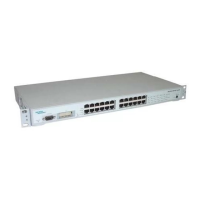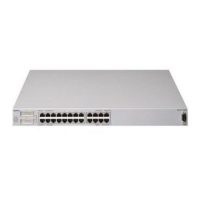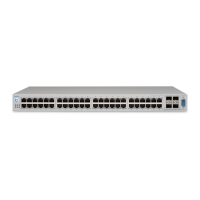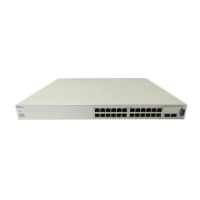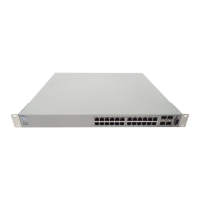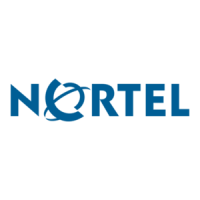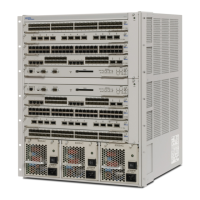Do you have a question about the Nortel BayStack 450-24T and is the answer not in the manual?
| Switching Capacity | 8.8 Gbps |
|---|---|
| Forwarding Rate | 35.7 Mpps |
| Layer | 2 |
| Weight | 4.5 kg |
| Flash Memory | 8 MB |
| Jumbo Frame Support | Yes |
| Manageable | Yes |
| Power Supply | Internal |
| Operating Humidity | 10% to 90% non-condensing |
| Features | VLAN, QoS |
| MAC Address Table | 8K |
| Operating Temperature | 0°C to 40°C |
| Ports | 24 x 10/100Base-TX |
| Uplink Ports | 2 x 1000Base-X (SFP) |
| Dimensions | 44.0 x 29.5 x 4.4 cm |
| MAC Address Table Size | 8K |
| Dimensions (W x D x H) | 44.0 x 29.5 x 4.4 cm |
Provides an overview of the different BayStack 450 switch models and their hardware components.
Lists the key capabilities and functionalities of the BayStack 450 switch, including performance and connectivity.
Details the support for SNMP agents, MIBs, and traps for network management.
Covers security features like MAC address-based, EAPOL-based, RADIUS-based, and SNMP-based security.
Describes parameters stored in flash memory, including software image and configuration.
Explains how to manage the switch configuration using various software and network tools.
Details the use of BootP for automatic IP address assignment and MAC address configuration.
Explains the switch's ability to automatically sense and negotiate port speeds and duplex modes.
Presents examples of different network setups and applications for the switch.
Describes how to configure and manage multiple switches connected in a stack.
Covers VLAN concepts, types (port-based, protocol-based), and 802.1Q tagging.
Explains how IGMP snooping optimizes IP multicast traffic flow.
Details how to prioritize packet forwarding based on user priority levels.
Explains how to group switch ports to increase bandwidth and resilience.
Describes how to configure port mirroring for network traffic monitoring.
Lists necessary items and environmental considerations for the switch installation.
Provides step-by-step instructions for installing the switch in a rack or on a flat surface.
Details the procedure for connecting the AC power cord and powering up the switch.
Explains how to verify the installation using LEDs and the self-test screen.
Guides through the initial configuration, including IP address settings.
Provides an overview of the main console interface options for switch management.
Details the process of configuring IP settings, subnet masks, and gateways.
Explains how to set up SNMP parameters for network monitoring and management.
Allows viewing of system information, hardware, firmware, and software versions.
Provides access to various configuration menus like MAC address, VLAN, and port settings.
Details the configuration of MAC address-based security features and system responses.
Covers assigning VLAN port memberships and creating VLANs.
Explains how to configure individual switch ports, including speed, duplex, and status.
Explains the meaning of the switch's LED indicators for status and errors.
Provides guidance on identifying symptoms and performing corrective actions for issues.
Lists and describes error codes encountered during software download processes.
Lists operating and storage specifications for temperature, humidity, and altitude.
Details input voltage, power consumption, and thermal output specifications.
Outlines key performance metrics like forwarding rate and address database size.
Describes the various physical connectors and interface types supported by the switch.
Provides optical characteristics for 1000BASE-SX Gigabit Ethernet MDAs.
Details optical characteristics for 1000BASE-LX Gigabit Ethernet MDAs.
Describes the 400-4TX MDA for standard Ethernet connections.
Covers the 400-2FX and 400-4FX MDAs for fiber optic connections.
Details the 450-1SX and 450-1SR MDAs for gigabit fiber connections.
Provides step-by-step instructions for installing Media Dependent Adapters.
Describes the process for installing Gigabit Interface Converters (GBICs).
Defines key terms and concepts related to Asynchronous Transfer Mode (ATM).
Explains the LANE protocol and its services for Ethernet over ATM networks.
Summarizes configuration concepts for operating ATM MDAs.
Discusses configuration rules for LAN Emulation Clients and VLANs.
Provides flowcharts for creating and modifying 802.1Q VLAN configurations.
Offers flowcharts for setting up MAC, RADIUS, and SNMP security configurations.
Presents flowcharts for creating and managing MultiLink trunk configurations.
Provides flowcharts for setting up port mirroring for network traffic monitoring.
Offers flowcharts for configuring IGMP snooping for multicast traffic optimization.
Describes the RJ-45 connectors, including pin assignments and cable types.
Explains MDI and MDI-X standards for Ethernet interfaces and cable connections.
Details the DB-9 connector pin assignments for console and serial port connections.
Lists the default settings for IP configuration parameters like BootP mode and addresses.
Shows the default settings for SNMP community strings, traps, and authentication.
Lists the default values for system information fields like reset count and power status.
Details the default settings for MAC address security features.
Lists the default settings for VLAN creation, naming, and management.
Shows the default settings for port status, autonegotiation, and speed/duplex.
